Qiegen Liu
Meta-information Guided Cross-domain Synergistic Diffusion Model for Low-dose PET Reconstruction
Dec 23, 2025Abstract:Low-dose PET imaging is crucial for reducing patient radiation exposure but faces challenges like noise interference, reduced contrast, and difficulty in preserving physiological details. Existing methods often neglect both projection-domain physics knowledge and patient-specific meta-information, which are critical for functional-semantic correlation mining. In this study, we introduce a meta-information guided cross-domain synergistic diffusion model (MiG-DM) that integrates comprehensive cross-modal priors to generate high-quality PET images. Specifically, a meta-information encoding module transforms clinical parameters into semantic prompts by considering patient characteristics, dose-related information, and semi-quantitative parameters, enabling cross-modal alignment between textual meta-information and image reconstruction. Additionally, the cross-domain architecture combines projection-domain and image-domain processing. In the projection domain, a specialized sinogram adapter captures global physical structures through convolution operations equivalent to global image-domain filtering. Experiments on the UDPET public dataset and clinical datasets with varying dose levels demonstrate that MiG-DM outperforms state-of-the-art methods in enhancing PET image quality and preserving physiological details.
Iterative Diffusion-Refined Neural Attenuation Fields for Multi-Source Stationary CT Reconstruction: NAF Meets Diffusion Model
Nov 18, 2025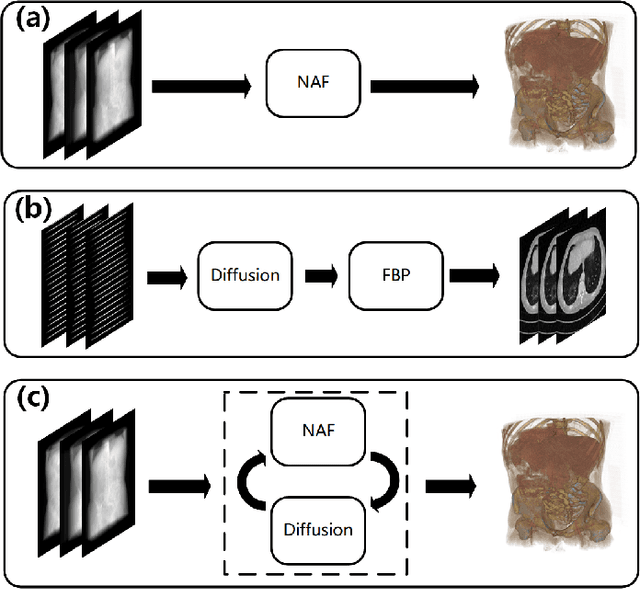
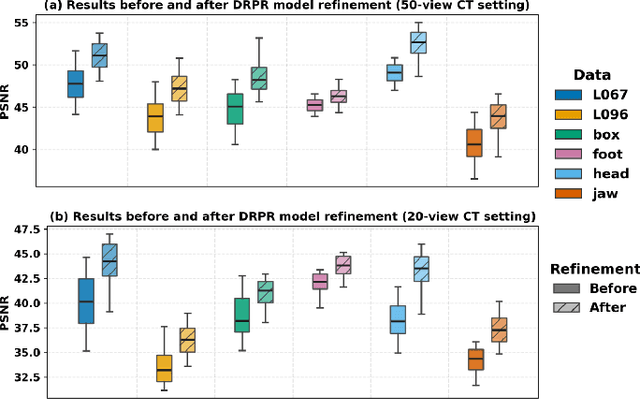
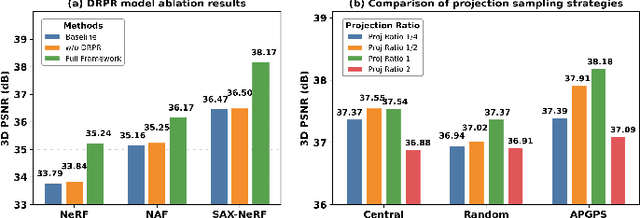
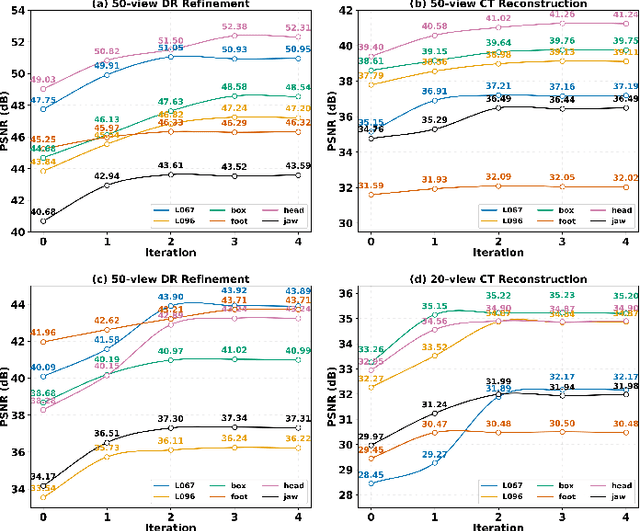
Abstract:Multi-source stationary computed tomography (CT) has recently attracted attention for its ability to achieve rapid image reconstruction, making it suitable for time-sensitive clinical and industrial applications. However, practical systems are often constrained by ultra-sparse-view sampling, which significantly degrades reconstruction quality. Traditional methods struggle under ultra-sparse-view settings, where interpolation becomes inaccurate and the resulting reconstructions are unsatisfactory. To address this challenge, this study proposes Diffusion-Refined Neural Attenuation Fields (Diff-NAF), an iterative framework tailored for multi-source stationary CT under ultra-sparse-view conditions. Diff-NAF combines a Neural Attenuation Field representation with a dual-branch conditional diffusion model. The process begins by training an initial NAF using ultra-sparse-view projections. New projections are then generated through an Angle-Prior Guided Projection Synthesis strategy that exploits inter view priors, and are subsequently refined by a Diffusion-driven Reuse Projection Refinement Module. The refined projections are incorporated as pseudo-labels into the training set for the next iteration. Through iterative refinement, Diff-NAF progressively enhances projection completeness and reconstruction fidelity under ultra-sparse-view conditions, ultimately yielding high-quality CT reconstructions. Experimental results on multiple simulated 3D CT volumes and real projection data demonstrate that Diff-NAF achieves the best performance under ultra-sparse-view conditions.
ALL-PET: A Low-resource and Low-shot PET Foundation Model in the Projection Domain
Sep 11, 2025Abstract:Building large-scale foundation model for PET imaging is hindered by limited access to labeled data and insufficient computational resources. To overcome data scarcity and efficiency limitations, we propose ALL-PET, a low-resource, low-shot PET foundation model operating directly in the projection domain. ALL-PET leverages a latent diffusion model (LDM) with three key innovations. First, we design a Radon mask augmentation strategy (RMAS) that generates over 200,000 structurally diverse training samples by projecting randomized image-domain masks into sinogram space, significantly improving generalization with minimal data. This is extended by a dynamic multi-mask (DMM) mechanism that varies mask quantity and distribution, enhancing data diversity without added model complexity. Second, we implement positive/negative mask constraints to embed strict geometric consistency, reducing parameter burden while preserving generation quality. Third, we introduce transparent medical attention (TMA), a parameter-free, geometry-driven mechanism that enhances lesion-related regions in raw projection data. Lesion-focused attention maps are derived from coarse segmentation, covering both hypermetabolic and hypometabolic areas, and projected into sinogram space for physically consistent guidance. The system supports clinician-defined ROI adjustments, ensuring flexible, interpretable, and task-adaptive emphasis aligned with PET acquisition physics. Experimental results show ALL-PET achieves high-quality sinogram generation using only 500 samples, with performance comparable to models trained on larger datasets. ALL-PET generalizes across tasks including low-dose reconstruction, attenuation correction, delayed-frame prediction, and tracer separation, operating efficiently with memory use under 24GB.
UniSino: Physics-Driven Foundational Model for Universal CT Sinogram Standardization
Aug 25, 2025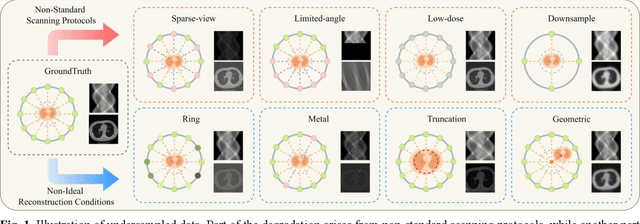

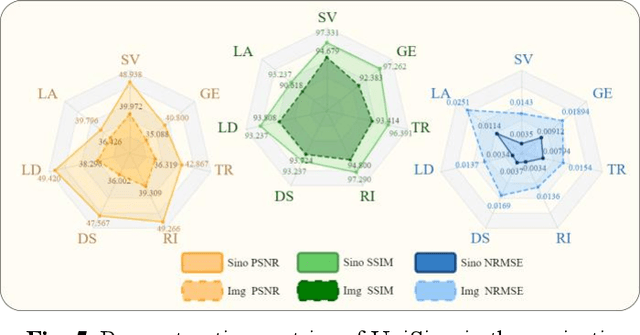
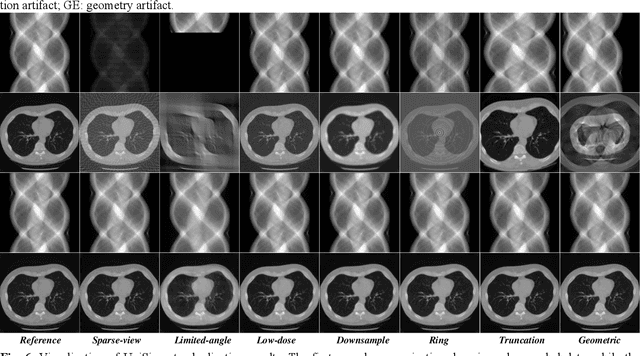
Abstract:During raw-data acquisition in CT imaging, diverse factors can degrade the collected sinograms, with undersampling and noise leading to severe artifacts and noise in reconstructed images and compromising diagnostic accuracy. Conventional correction methods rely on manually designed algorithms or fixed empirical parameters, but these approaches often lack generalizability across heterogeneous artifact types. To address these limitations, we propose UniSino, a foundation model for universal CT sinogram standardization. Unlike existing foundational models that operate in image domain, UniSino directly standardizes data in the projection domain, which enables stronger generalization across diverse undersampling scenarios. Its training framework incorporates the physical characteristics of sinograms, enhancing generalization and enabling robust performance across multiple subtasks spanning four benchmark datasets. Experimental results demonstrate thatUniSino achieves superior reconstruction quality both single and mixed undersampling case, demonstrating exceptional robustness and generalization in sinogram enhancement for CT imaging. The code is available at: https://github.com/yqx7150/UniSino.
PRO: Projection Domain Synthesis for CT Imaging
Jun 16, 2025Abstract:Synthesizing high quality CT images remains a signifi-cant challenge due to the limited availability of annotat-ed data and the complex nature of CT imaging. In this work, we present PRO, a novel framework that, to the best of our knowledge, is the first to perform CT image synthesis in the projection domain using latent diffusion models. Unlike previous approaches that operate in the image domain, PRO learns rich structural representa-tions from raw projection data and leverages anatomi-cal text prompts for controllable synthesis. This projec-tion domain strategy enables more faithful modeling of underlying imaging physics and anatomical structures. Moreover, PRO functions as a foundation model, capa-ble of generalizing across diverse downstream tasks by adjusting its generative behavior via prompt inputs. Experimental results demonstrated that incorporating our synthesized data significantly improves perfor-mance across multiple downstream tasks, including low-dose and sparse-view reconstruction, even with limited training data. These findings underscore the versatility and scalability of PRO in data generation for various CT applications. These results highlight the potential of projection domain synthesis as a powerful tool for data augmentation and robust CT imaging. Our source code is publicly available at: https://github.com/yqx7150/PRO.
Ordered-subsets Multi-diffusion Model for Sparse-view CT Reconstruction
May 15, 2025Abstract:Score-based diffusion models have shown significant promise in the field of sparse-view CT reconstruction. However, the projection dataset is large and riddled with redundancy. Consequently, applying the diffusion model to unprocessed data results in lower learning effectiveness and higher learning difficulty, frequently leading to reconstructed images that lack fine details. To address these issues, we propose the ordered-subsets multi-diffusion model (OSMM) for sparse-view CT reconstruction. The OSMM innovatively divides the CT projection data into equal subsets and employs multi-subsets diffusion model (MSDM) to learn from each subset independently. This targeted learning approach reduces complexity and enhances the reconstruction of fine details. Furthermore, the integration of one-whole diffusion model (OWDM) with complete sinogram data acts as a global information constraint, which can reduce the possibility of generating erroneous or inconsistent sinogram information. Moreover, the OSMM's unsupervised learning framework provides strong robustness and generalizability, adapting seamlessly to varying sparsity levels of CT sinograms. This ensures consistent and reliable performance across different clinical scenarios. Experimental results demonstrate that OSMM outperforms traditional diffusion models in terms of image quality and noise resilience, offering a powerful and versatile solution for advanced CT imaging in sparse-view scenarios.
ESDiff: Encoding Strategy-inspired Diffusion Model with Few-shot Learning for Color Image Inpainting
Apr 24, 2025Abstract:Image inpainting is a technique used to restore missing or damaged regions of an image. Traditional methods primarily utilize information from adjacent pixels for reconstructing missing areas, while they struggle to preserve complex details and structures. Simultaneously, models based on deep learning necessitate substantial amounts of training data. To address this challenge, an encoding strategy-inspired diffusion model with few-shot learning for color image inpainting is proposed in this paper. The main idea of this novel encoding strategy is the deployment of a "virtual mask" to construct high-dimensional objects through mutual perturbations between channels. This approach enables the diffusion model to capture diverse image representations and detailed features from limited training samples. Moreover, the encoding strategy leverages redundancy between channels, integrates with low-rank methods during iterative inpainting, and incorporates the diffusion model to achieve accurate information output. Experimental results indicate that our method exceeds current techniques in quantitative metrics, and the reconstructed images quality has been improved in aspects of texture and structural integrity, leading to more precise and coherent results.
Virtual-mask Informed Prior for Sparse-view Dual-Energy CT Reconstruction
Apr 10, 2025Abstract:Sparse-view sampling in dual-energy computed tomography (DECT) significantly reduces radiation dose and increases imaging speed, yet is highly prone to artifacts. Although diffusion models have demonstrated potential in effectively handling incomplete data, most existing methods in this field focus on the image do-main and lack global constraints, which consequently leads to insufficient reconstruction quality. In this study, we propose a dual-domain virtual-mask in-formed diffusion model for sparse-view reconstruction by leveraging the high inter-channel correlation in DECT. Specifically, the study designs a virtual mask and applies it to the high-energy and low-energy data to perform perturbation operations, thus constructing high-dimensional tensors that serve as the prior information of the diffusion model. In addition, a dual-domain collaboration strategy is adopted to integrate the information of the randomly selected high-frequency components in the wavelet domain with the information in the projection domain, for the purpose of optimizing the global struc-tures and local details. Experimental results indicated that the present method exhibits excellent performance across multiple datasets.
Diffusion Transformer Meets Random Masks: An Advanced PET Reconstruction Framework
Mar 11, 2025Abstract:Deep learning has significantly advanced PET image re-construction, achieving remarkable improvements in image quality through direct training on sinogram or image data. Traditional methods often utilize masks for inpainting tasks, but their incorporation into PET reconstruction frameworks introduces transformative potential. In this study, we pro-pose an advanced PET reconstruction framework called Diffusion tRansformer mEets rAndom Masks (DREAM). To the best of our knowledge, this is the first work to integrate mask mechanisms into both the sinogram domain and the latent space, pioneering their role in PET reconstruction and demonstrating their ability to enhance reconstruction fidelity and efficiency. The framework employs a high-dimensional stacking approach, transforming masked data from two to three dimensions to expand the solution space and enable the model to capture richer spatial rela-tionships. Additionally, a mask-driven latent space is de-signed to accelerate the diffusion process by leveraging sinogram-driven and mask-driven compact priors, which reduce computational complexity while preserving essen-tial data characteristics. A hierarchical masking strategy is also introduced, guiding the model from focusing on fi-ne-grained local details in the early stages to capturing broader global patterns over time. This progressive ap-proach ensures a balance between detailed feature preservation and comprehensive context understanding. Experimental results demonstrate that DREAM not only improves the overall quality of reconstructed PET images but also preserves critical clinical details, highlighting its potential to advance PET imaging technology. By inte-grating compact priors and hierarchical masking, DREAM offers a promising and efficient avenue for future research and application in PET imaging. The open-source code is available at: https://github.com/yqx7150/DREAM.
Physics-informed DeepCT: Sinogram Wavelet Decomposition Meets Masked Diffusion
Jan 17, 2025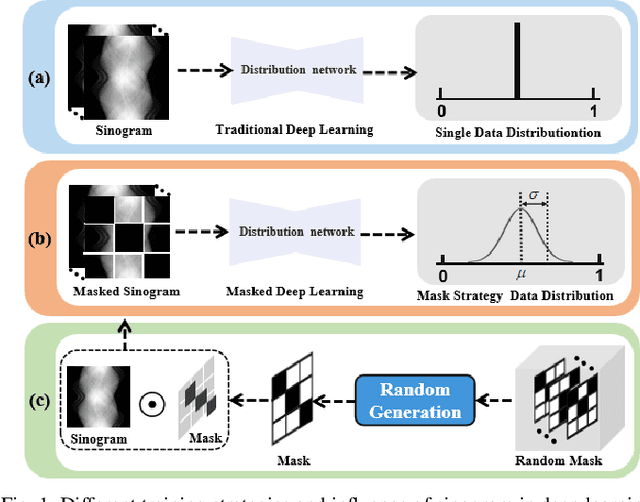
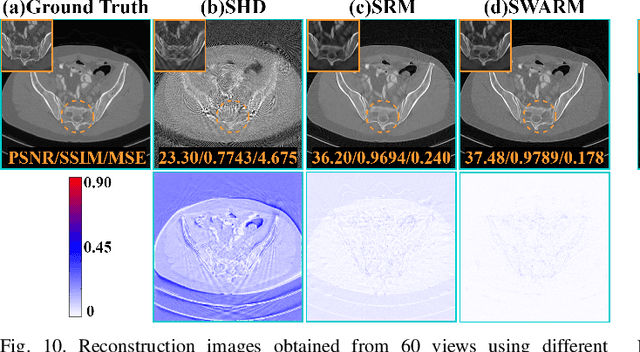
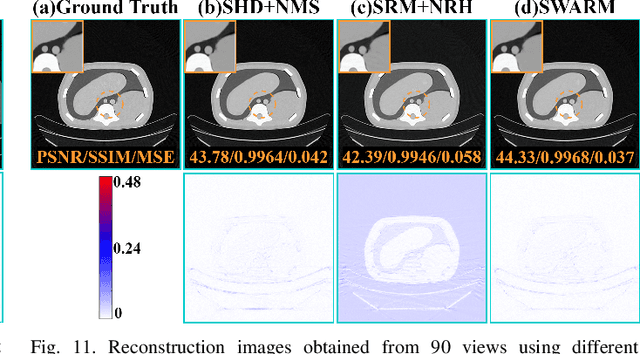
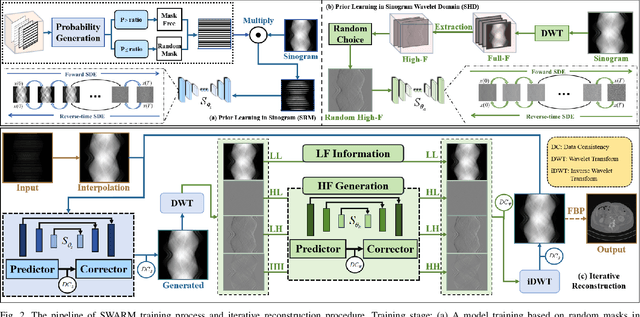
Abstract:Diffusion model shows remarkable potential on sparse-view computed tomography (SVCT) reconstruction. However, when a network is trained on a limited sample space, its generalization capability may be constrained, which degrades performance on unfamiliar data. For image generation tasks, this can lead to issues such as blurry details and inconsistencies between regions. To alleviate this problem, we propose a Sinogram-based Wavelet random decomposition And Random mask diffusion Model (SWARM) for SVCT reconstruction. Specifically, introducing a random mask strategy in the sinogram effectively expands the limited training sample space. This enables the model to learn a broader range of data distributions, enhancing its understanding and generalization of data uncertainty. In addition, applying a random training strategy to the high-frequency components of the sinogram wavelet enhances feature representation and improves the ability to capture details in different frequency bands, thereby improving performance and robustness. Two-stage iterative reconstruction method is adopted to ensure the global consistency of the reconstructed image while refining its details. Experimental results demonstrate that SWARM outperforms competing approaches in both quantitative and qualitative performance across various datasets.
 Add to Chrome
Add to Chrome Add to Firefox
Add to Firefox Add to Edge
Add to Edge